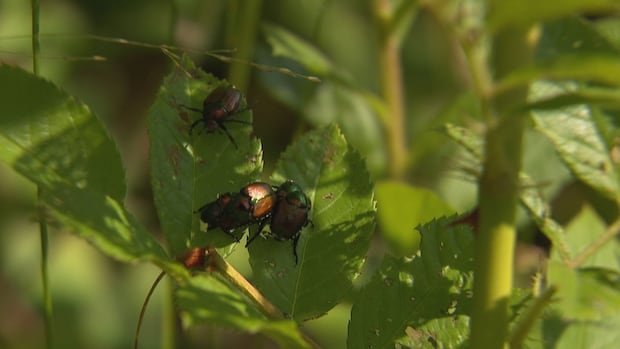Gardeners in the Halifax area are facing a persistent challenge from Japanese beetles, damaging rose bushes and devouring backyard crops. Despite the prevalence of these insects, there is a lack of consensus on the most effective methods to address the issue.
Shawn Spurr, a long-time gardener in Dartmouth, discovered Japanese beetles on his flourishing pea plants, leaving behind only a few flowers after feeding on the tops.
Expressing his frustration, Spurr mentioned that the beetles have also targeted his tomato plants, peppers, and possibly his potatoes, which he will only confirm upon harvesting.

This year, Spurr noted that the Japanese beetle infestation is the most severe he has witnessed.
While these beetles have been present in Nova Scotia as an invasive species for nearly a century, their populations have surged recently due to favorable winter survival conditions attributed to climate change, as explained by Paul Manning, an entomology professor at Dalhousie University in Halifax.
Manning highlighted that the beetle population is expanding into new areas, thriving in human-influenced environments rich in their preferred plant species.
He further explained that the natural predators and parasites of the Japanese beetles have not yet caught up with their rapid spread, but once they do, the beetle population is expected to decline significantly.
Although the beetles are currently at their peak activity, Manning mentioned that this phase typically lasts only a few weeks.
Considerations on Trapping
Various remedies are available to combat Japanese beetles, but few are highly effective according to Manning. Killing them can release a pheromone that attracts more beetles.
Manning emphasized the challenges of using insecticides in outdoor gardens and the limited efficacy of pheromone traps, which mainly confirm the presence of the beetles and may draw more towards nearby plants.
He advised against relying solely on traps, as significant quantities would be needed along with frequent pheromone replacements to make a notable impact on the beetle population.
Instead, Manning recommended a hands-on approach of spending time each evening, when the beetles are less active, manually removing and disposing of them in soapy water, which he deemed as the most successful strategy.
However, some individuals find this method impractical, as mentioned by Alexander Godfrey, the nursery lead at Lakeland Plant World in Westphal, who suggested placing pheromone traps strategically to divert the beetles away from plants.
Godfrey shared that utilizing traps has proven effective in safeguarding their greenhouse’s stock from beetle infestations.
Combining Strategies
Spurr experimented with both hand-picking and using a pheromone trap to address the beetle issue in his garden. He found the trap to be a time-saving solution, noticing a difference in just a few days, although he remains uncertain about the exact origin of the captured beetles.
According to Manning, while the Japanese beetles are not yet posing a significant threat to large-scale agriculture, vineyards and hops growers are at higher risk of infestation.

